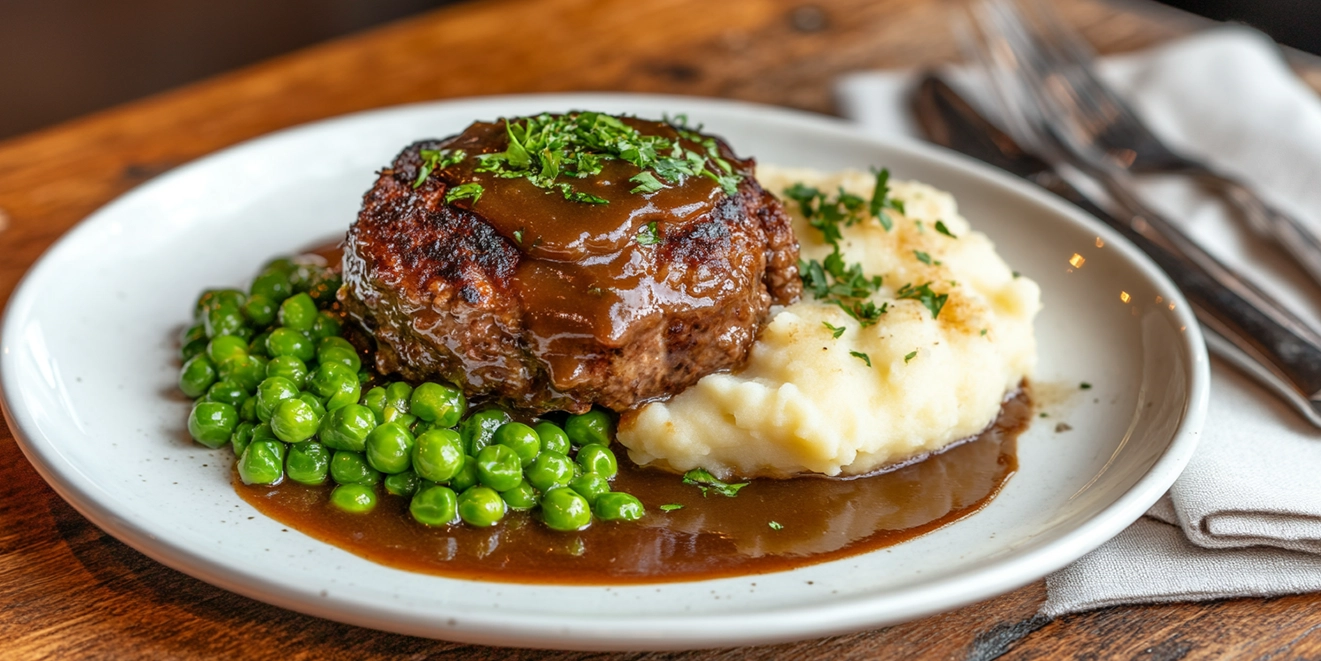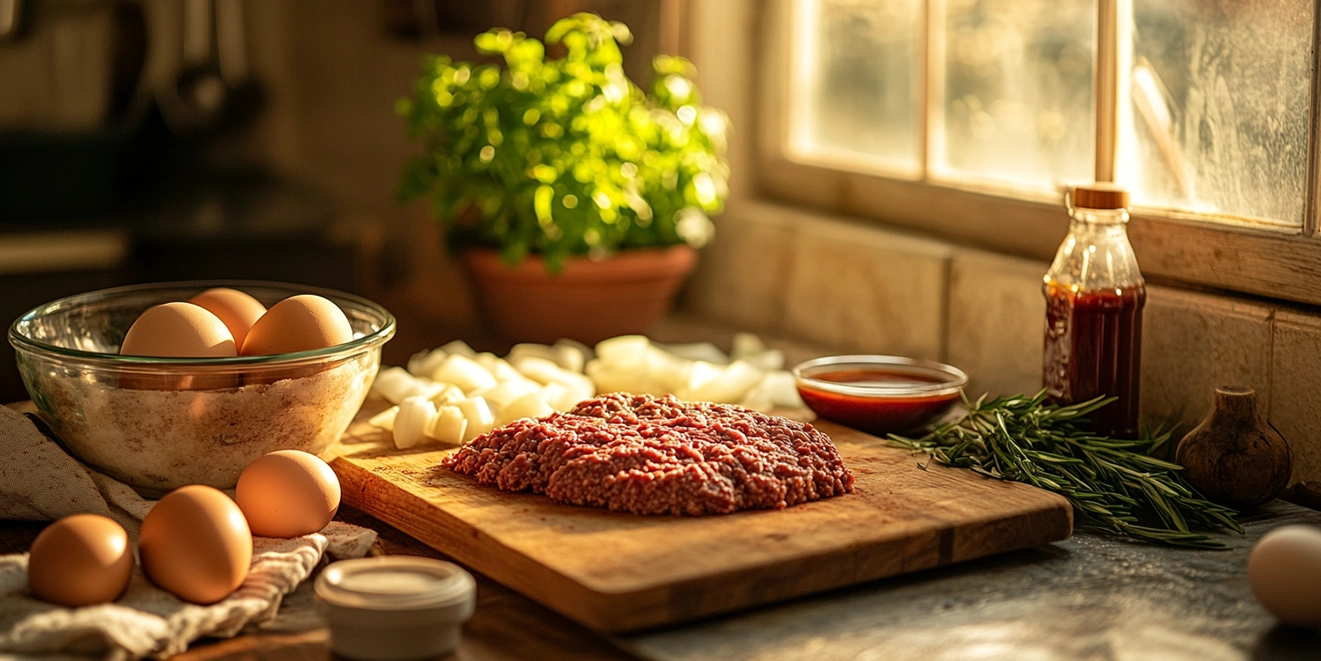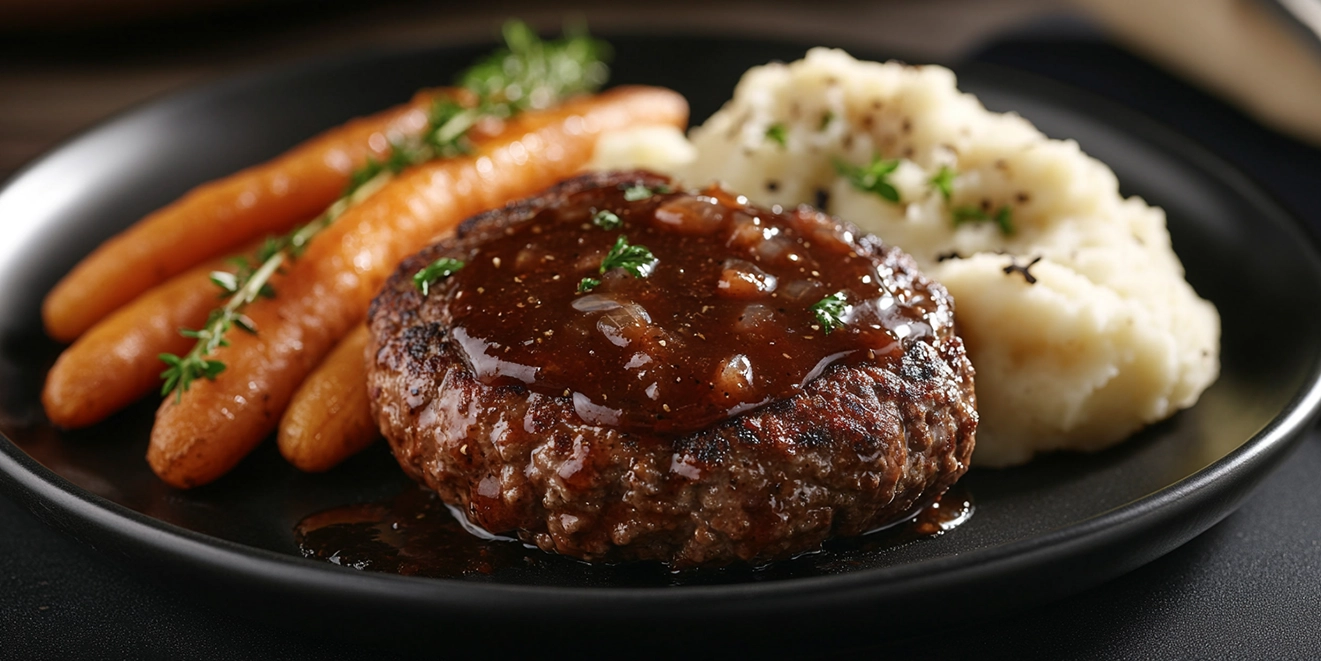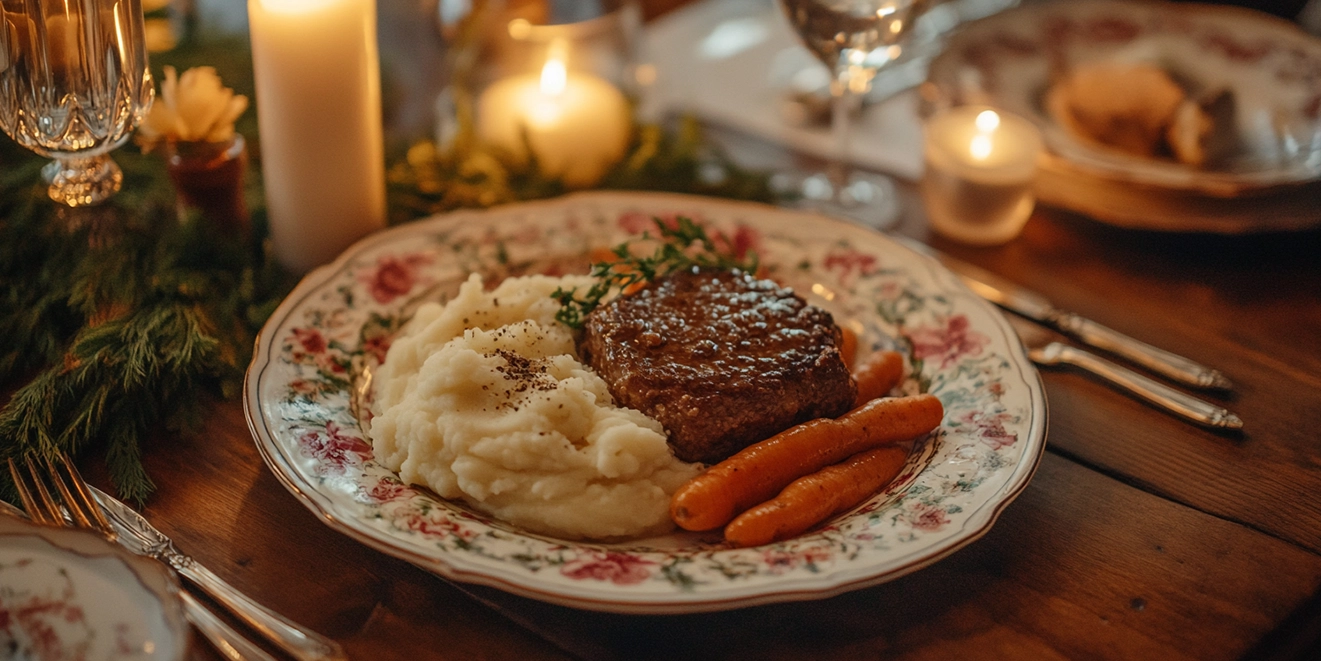
Table of Contents
Introduction to Salisbury Steak
What Is Salisbury Steak?
Salisbury steak is a classic comfort food that blends simplicity with hearty flavors. At its core, it consists of seasoned ground beef shaped into a steak-like patty, often served with a rich, savory brown gravy. The dish is typically accompanied by sides like mashed potatoes or vegetables, making it a well-rounded meal.
The origins of Salisbury steak trace back to Dr. James Henry Salisbury, an American physician in the 19th century. He advocated for a meat-centric diet as part of a healthy lifestyle, and the dish was named in his honor. Initially promoted for its nutritional benefits, Salisbury steak has since evolved into a beloved staple in households and diners across the globe.
Salisbury Steak vs. Hamburger Steak
While Salisbury steak and hamburger steak may seem similar at first glance, they have key distinctions that set them apart.
- Ingredients:
- Salisbury steak typically includes breadcrumbs, eggs, onions, and a mix of seasonings in the beef mixture. These ingredients give it a softer texture and a more complex flavor profile. On the other hand, hamburger steak is often more straightforward, consisting primarily of ground beef with minimal additives.
- Preparation:
- Salisbury steak is almost always served with a thick, flavorful gravy made from beef stock, onions, and sometimes mushrooms. Hamburger steak can also be served with gravy, but it is commonly served plain or with basic condiments like ketchup.
- Presentation:
- Salisbury steak is shaped to resemble a traditional steak, often oval or oblong, whereas hamburger steak can sometimes look more like a patty or burger without a bun.
- Historical Context:
- Salisbury steak has its roots in the 19th century and is associated with Dr. Salisbury’s dietary theories. Hamburger steak emerged later as a simpler, more casual variation closely linked to the evolution of burgers.
Ingredients Needed for Salisbury Steak

Main Ingredients
The foundation of Salisbury steak lies in its flavorful, well-seasoned patty. Here are the core ingredients you’ll need:
- Ground Beef: Use lean or medium-fat ground beef to balance flavor and texture. Too much fat can make the patties greasy, while too little may result in a dry steak.
- Breadcrumbs: These help bind the patties together and give them a tender texture. Plain breadcrumbs work best, but seasoned breadcrumbs can add extra flavor.
- Eggs: A crucial binding agent that ensures the patties hold their shape during cooking.
- Onions: Finely chopped onions add moisture and a subtle sweetness to the mixture, enhancing the overall flavor.
- Seasonings: A combination of salt, pepper, garlic powder, and parsley provides a well-rounded taste. Feel free to adjust the seasonings to suit your preferences.
Sauce Ingredients
The rich, savory sauce elevates Salisbury steak from a simple patty to a satisfying meal. Here’s what you need for the gravy:
- Beef Broth: The base of the sauce, beef broth, provides a deep, umami-rich flavor. If you’re watching your salt intake, opt for low-sodium broth.
- Worcestershire Sauce: Adds a tangy, savory complexity to the sauce.
- Flour or Cornstarch thickens the gravy, creating a silky, velvety consistency.
- Butter: Adds richness and enhances the sauce’s flavor.
- Onions and Garlic: Sautéed in butter, these add depth and aroma to the gravy.
- Optional Cream: To make the sauce richer, add a splash of cream for a touch of indulgence.
Optional Add-Ons
Enhance your Salisbury steak with these optional ingredients to add variety and elevate the dish:
- Mushrooms: Sliced mushrooms add an earthy, savory note to the sauce and complement the beef perfectly.
- Herbs: Fresh thyme, parsley, or rosemary can provide a fragrant, herbal touch.
- Cheese: Incorporate shredded cheese into the patties for a creamy, indulgent twist.
- Vegetables: Add finely grated carrots or zucchini to the beef mixture for extra moisture and nutrition.
- Spices: For a bolder flavor, try adding paprika, cayenne, or mustard powder to the mix.
Essential Equipment for Making Salisbury Steak
Kitchen Tools
To prepare Salisbury steak efficiently and achieve the best results, you’ll need a few essential kitchen tools:
- Mixing Bowls: Combining the ground beef, breadcrumbs, eggs, and seasonings into a cohesive mixture. Use a medium to a large bowl to make mixing easier.
- Skillet: A heavy-bottomed skillet or frying pan is ideal for searing the patties and cooking the sauce. Cast iron or stainless steel works best for even heat distribution.
- Spatula: A sturdy spatula makes it easy to flip the patties without breaking them.
- Whisk: Essential for mixing the gravy ingredients to achieve a smooth consistency.
- Knife and Cutting Board: Chopping onions, garlic, and other ingredients like mushrooms or herbs.
- Measuring Cups and Spoons: Ensure accurate measurements of ingredients for consistent flavor.
- Tongs: Useful for handling the patties during cooking and plating.
- Small Saucepan (Optional): A small saucepan will come in handy if you prefer to prepare the gravy separately before combining it with the patties.
Cooking Techniques
Mastering these techniques will help you achieve perfectly cooked Salisbury steak with rich, flavorful gravy:
- Mixing the Patties: Use your hands to combine the ground beef mixture gently. Overmixing can make the patties dense, so mix until the ingredients are evenly distributed.
- Shaping the Patties: Form oval-shaped patties that are about ½-inch thick. This shape ensures even cooking and gives the classic Salisbury steak appearance.
- Searing the Patties: Heat your skillet over medium-high heat and sear the patties for a few minutes on each side. This locks in the juices and adds a flavorful crust.
- Deglazing the Pan: After cooking the patties, deglaze the skillet with beef broth or a splash of Worcestershire sauce. This step lifts the flavorful browned bits (fond) from the bottom of the pan, which enhances the sauce.
- Making the Gravy: Whisk flour or Cornstarch into the deglazed liquid and cook until it thickens. Stir constantly to prevent lumps and ensure a smooth, velvety texture.
- Simmering: Once the gravy is ready, return the patties to the skillet and let them simmer in the sauce. This step infuses the patties with flavor and ensures they are fully cooked.
Step-by-Step Instructions
Preparing the Patties
- Gather Ingredients: In a mixing bowl, combine the following:
- 1 pound (450g) of ground beef
- ½ cup breadcrumbs
- One egg
- One small onion, finely chopped
- One teaspoon of garlic powder
- One teaspoon salt
- ½ teaspoon black pepper
- One tablespoon Worcestershire sauce (optional for added flavor)
- Mix: Use clean hands or a spatula to combine the ingredients gently. Be careful not to overmix, as this can make the patties dense.
- Shape: Divide the mixture into four equal portions and shape them into oval or oblong patties about ½-inch thick. Set them aside on a plate.
Cooking the Patties
- Heat the Skillet: Place a large skillet over medium-high heat and add 1-2 tablespoons of oil or butter. Allow the pan to heat until the oil shimmers.
- Sear the Patties: Add the patties to the skillet in a single layer. Sear for 3-4 minutes on each side until a golden-brown crust forms. This step locks in the juices and enhances the flavor.
- Remove and Set Aside: Transfer the patties to a plate once browned. They don’t need to be fully cooked at this stage, as they’ll finish cooking in the gravy.
Making the Gravy
- Sauté Aromatics: Add one small onion (thinly sliced) and 1-2 minced garlic cloves in the same skillet. Sauté for 2-3 minutes until softened and fragrant.
- Deglaze the Pan: Pour in 2 cups of beef broth, scraping up any browned bits from the bottom of the pan. This adds depth to the sauce.
- Thicken the Sauce: In a small bowl, mix two tablespoons of flour or Cornstarch with two tablespoons of water to form a slurry. Slowly whisk this into the broth, ensuring there are no lumps.
- Season the Gravy: Add one tablespoon of Worcestershire sauce, a pinch of salt, and a dash of black pepper. For a creamier gravy, stir in 2-3 tablespoons of heavy cream (optional).
Combining and Simmering
- Return Patties to the Skillet: Carefully place the seared patties back into the skillet, submerging them in the gravy.
- Simmer: Reduce the heat to low, cover the skillet, and let everything simmer for 10-15 minutes. This allows the patties to finish cooking and soak up the gravy flavors.
- Check for Doneness: Ensure the patties’ internal temperature reaches 160°F (71°C) for safe consumption.
- Serve: Plate the Salisbury steak alongside mashed potatoes, rice, or vegetables, and generously spoon the gravy over the top.
Serving Suggestions

Salisbury Steak pairs beautifully with a range of sides. For a classic pairing, enjoy it with mashed potatoes, or try it alongside baked beans for a backyard barbecue vibe. For a vegetable option, consider steamed broccoli or a crisp green salad.
To explore other comforting dinner ideas, check out this chuck roast recipe, which offers another tender, flavor-packed meat option.
Nutritional Information
Caloric Breakdown
A typical serving of Salisbury steak with gravy (without sides) contains approximately 350-400 calories. The calorie count may vary depending on the fat content of the beef, the amount of gravy, and any additional ingredients or optional add-ons like mushrooms or cream. Here’s a breakdown of where the calories come from:
- Beef Patties Account for the majority of calories, roughly 250-300 calories, depending on the size and fat content.
- Gravy: Contributes about 100 calories, especially if made with butter, beef broth, and thickening agents. Cream-based gravy will add slightly more calories.
Macronutrient Content
Here’s an approximate breakdown of the macronutrients in one serving of Salisbury steak with gravy:
- Protein:
- 20-25g per serving: Ground beef is the primary source of protein, making Salisbury steak a high-protein dish that supports muscle building and repair.
- Fats:
- 20-25g per serving: The fat content depends on the ground beef used. Using leaner beef (e.g., 90/10) can reduce the fat levels. The gravy also contributes to the fat content, mainly if butter or cream is used.
- Carbohydrates:
- 10-15g per serving: Breadcrumbs in the patties and flour or Cornstarch in the gravy are the primary carbohydrate sources. Adding optional ingredients like mushrooms or herbs does not significantly increase carbs.
Tips for Adjusting Nutritional Content
- Lower-Calorie Version: Use lean ground beef, reduce the butter in the gravy, and skip the heavy cream.
- Higher Protein: Mix extra egg whites or add finely chopped beans or lentils to the beef mixture.
- Lower Carb: Use almond flour or crushed pork rinds instead of breadcrumbs, and opt for a gluten-free thickener for the gravy.
Pairing Ideas and Serving Suggestions
Best Side Dishes
Salisbury steak pairs beautifully with a variety of comforting and flavorful side dishes. Here are some top choices to round out your meal:
- Mashed Potatoes:
- This creamy, buttery classic perfectly soaks up the rich gravy. For an extra layer of flavor, consider garlic mashed potatoes.
- Roasted Vegetables:
- Oven-roasted carrots, green beans, or Brussels sprouts add a caramelized sweetness and balance the savory steak.
- Steamed Rice:
- Plain or seasoned rice provides a neutral base that highlights the bold flavors of the steak and gravy.
- Buttered Noodles:
- Egg noodles tossed in butter and parsley are simple yet satisfying, ideal for soaking up the gravy.
- Creamed Spinach:
- A rich and creamy side that complements the meaty flavor of Salisbury steak.
- Garden Salad:
- A fresh, crisp salad with a tangy vinaigrette offers a light counterpoint to the hearty main dish.

Frequently Asked Questions
What is a Salisbury steak made of?
Salisbury steak is primarily ground beef combined with breadcrumbs, egg, and onions for binding and flavor. The beef mixture is shaped into oval patties and typically served with a rich, savory brown gravy made from beef broth, Worcestershire sauce, and seasonings. Optional add-ins like mushrooms or herbs can enhance the dish.
What’s the difference between hamburger steak and Salisbury steak?
The main differences lie in the ingredients and presentation:
- Ingredients: Salisbury steak includes breadcrumbs, eggs, and seasonings in the beef mixture, making it more flavorful and tender. Hamburger steak is more straightforward, often just ground beef with minimal seasonings.
- Gravy: Salisbury steak is always served with a thick gravy, while hamburger steak may be served plain or with lighter sauces.
- Shape: Salisbury steak is shaped to resemble a traditional steak (oval), while hamburger steak is more akin to a burger patty.
What can I use instead of breadcrumbs in Salisbury steak?
If you’re out of breadcrumbs or need a substitute, here are some alternatives:
- Crushed Crackers: Saltines or Ritz crackers work well as a binding agent.
- Oats: Rolled oats (lightly blended for a finer texture) can be used, especially in gluten-free recipes.
- Almond Flour: A low-carb option for those on keto or gluten-free diets.
- Crushed Pork Rinds: Another keto-friendly choice that adds flavor and texture.
- Cooked Rice: A softer option that binds the patties and adds bulk.
What is a substitute for beef broth in Salisbury steak?
If you don’t have beef broth on hand, you can use these alternatives:
- Chicken Broth: A milder option that still provides a savory base. Add a splash of Worcestershire sauce for depth.
- Vegetable Broth: A vegetarian-friendly alternative, though it may lack the beefy richness.
- Soy Sauce and Water: Mix one tablespoon of soy sauce with 1 cup of water for a quick and flavorful substitute.
- Bouillon Cubes or Powder: Dissolve in hot water to create a broth substitute.
Conclusion
Salisbury steak is a timeless dish that combines simplicity with hearty, comforting flavors. With its juicy, seasoned beef patties and rich, savory gravy, it has become a favorite meal for families and food enthusiasts. Whether served with classic sides like mashed potatoes and roasted vegetables or paired with your favorite beverage, this dish offers versatility and satisfaction for any occasion.
By understanding its origins, ingredients, and preparation techniques, you can easily recreate Salisbury steak in your kitchen and customize it to suit your tastes. You’re well-equipped to make a delicious and memorable dish with the tips and guidance provided. Salisbury steak is more than just a meal—it’s a comforting tradition that brings warmth and joy.
More Recipes to Try
Looking for more culinary inspiration? Salisbury Steak also complements dishes like pepper steak for those who enjoy bold, peppery flavors or smoked brisket for a smoky twist on a meat-based meal. As a lighter, veggie-packed option, you might also want a comforting chicken and broccoli recipe.
